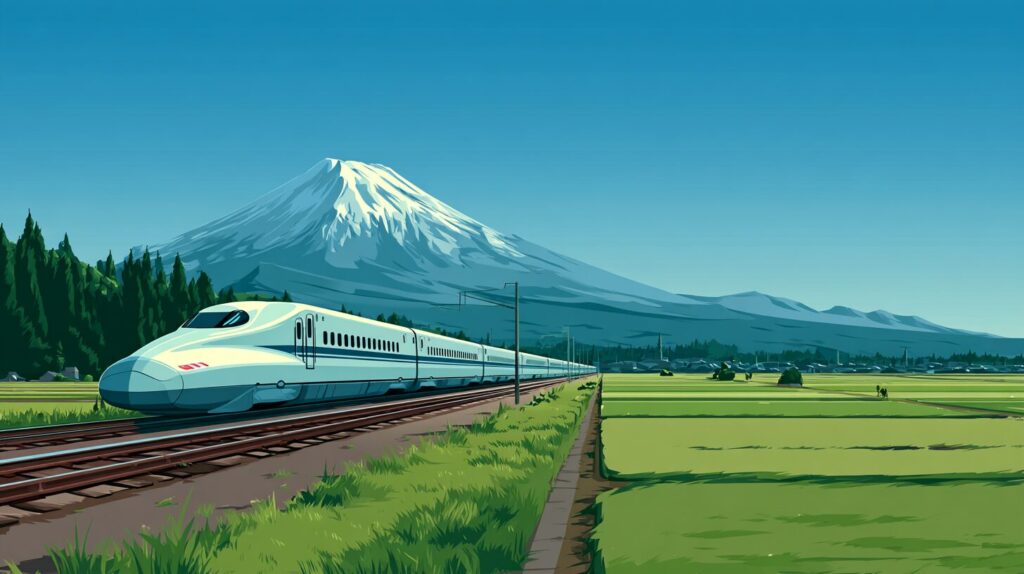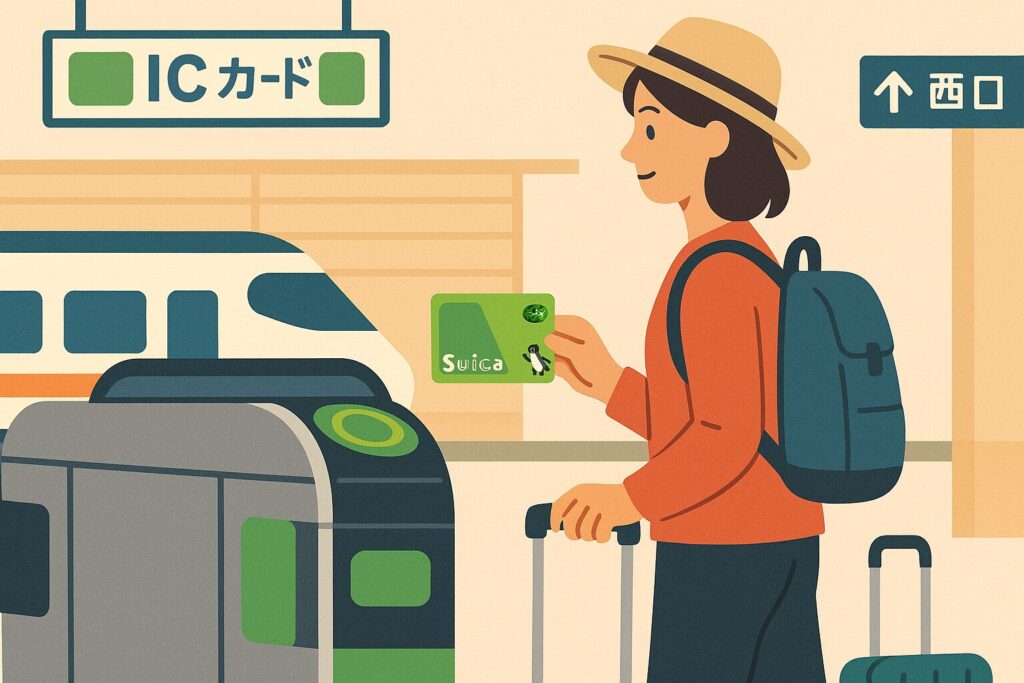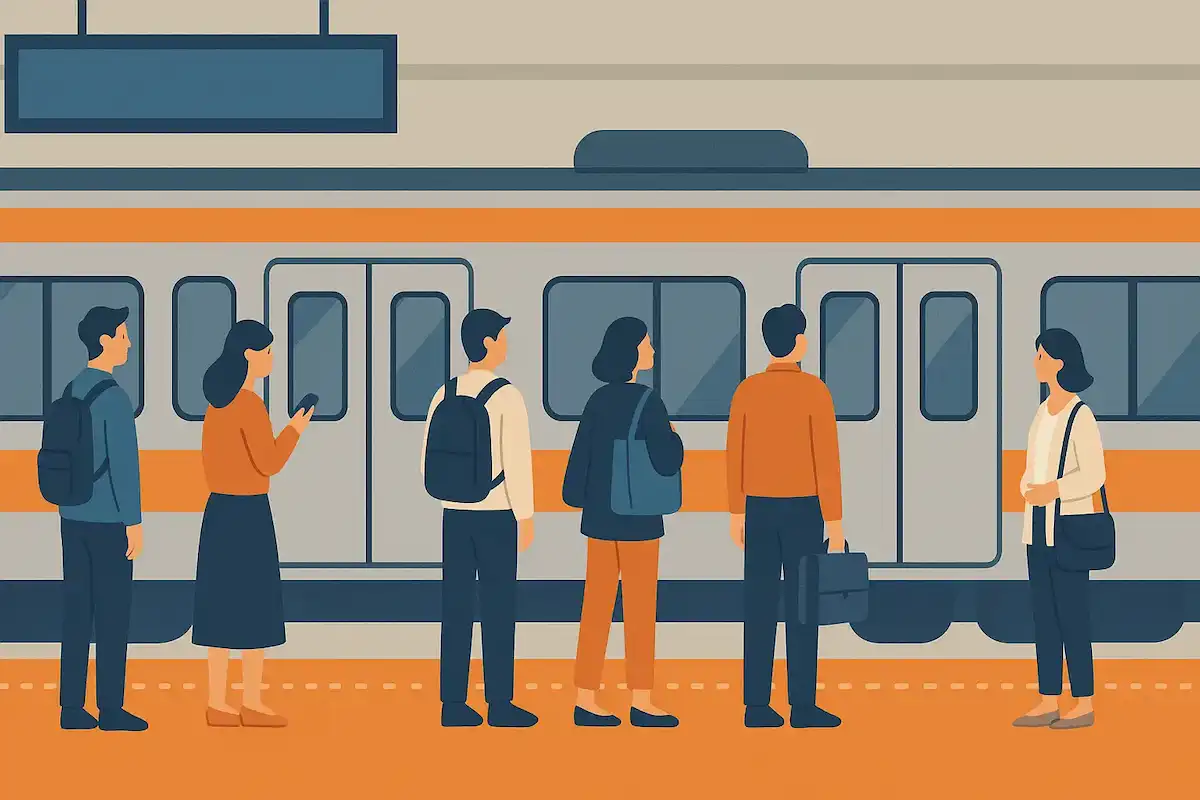日本の公共交通機関を英語で説明・紹介するための基本情報と、英会話に役立つ表現をシンプルでわかりやすい英語で紹介します。
英会話ダイアローグ・概要・10の質問を通して、日本の公共交通機関に関する英語表現を学びます。
英語
英会話ダイアローグを読む前に知っておくと良い前提知識と情報です。
- 日本の公共交通機関の基本
- 日本の主要な公共交通機関は電車(新幹線・JR・私鉄)、地下鉄、バス、タクシーなど
- 特に都市部では電車や地下鉄のネットワークが発達している
- 時間の正確さと清潔さ
- 日本の電車やバスは時刻通りに運行されることで有名
- 駅や車内は非常に清潔に保たれている
- ICカードの普及
- SuicaやPASMOなどのICカードが広く使われている
- 切符を買わずに電車・バスの乗車や買い物もできる
- 新幹線の特徴
- 新幹線は日本独自の高速鉄道で、都市間の移動が速くて快適
- 東京から大阪まで約2時間半で結ぶ
- 在来線とは別料金で、特急券と乗車券が必要
- 混雑や地方の課題
- 朝7-9時、夕方17-19時の都市部の通勤ラッシュは非常に混雑する
- 地方では本数が少なく、人口減少による地方の路線廃止も社会問題となっている
- 観光客向けサービス
- Japan Rail Passなど、外国人観光客向けの特別なパスや多言語案内が充実
- 安全性と自然災害
- 日本の公共交通は安全だが、地震や台風の際は運休や遅延が発生することもある
2人が日本の公共交通機関について話しています。
時間の正確性や清潔さ、ICカードの便利さといった優れた点から、混雑や地方での課題、観光客向けサービスなどを話題にしています。
会話 / dialogue

You know, since I moved to Tokyo, I’ve become really fascinated by Japanese public transportation. There’s so much more to it than just getting from one place to another.

Oh, definitely. I think a lot of people are surprised by how complex, yet user-friendly, the system actually is. What interests you the most?

Well, for one thing, how punctual everything is. Trains and buses almost never seem to be late. Back in my country, even a five-minute delay isn’t unusual.

That’s true. In Japan, even a one-minute delay can make the news! The focus on being on time is really a part of the culture here.

I’ve also noticed how clean everything is—the stations, the trains, even the public restrooms. It’s honestly impressive.

Cleanliness is definitely a point of pride. There are staff cleaning throughout the day, and passengers try to keep things tidy, too.

Using the IC cards like Suica has been so convenient. I hardly ever buy paper tickets now.

Same here. And you can use those cards on most trains, subways, and buses—not just in Tokyo, but in many other cities, too. You can even use them for shopping at convenience stores.

That surprised me! It makes everything much easier, especially for someone new to Japan.

Have you tried the shinkansen yet?

Not yet, but I really want to. I’ve heard it’s super fast and comfortable. Do you use it often?

Sometimes for work or travel. It’s a bit expensive, but the speed and comfort are worth it. It connects major cities and is very reliable.

I’m also amazed at how wide the network is. Even some small towns have frequent trains or buses.

That’s true, but actually, public transportation in the countryside isn’t as frequent as in the city. Sometimes you have to wait a long time, and you might need to pay in cash.

I see. So, there are still some challenges?

For sure. Rush hour in Tokyo can be very intense—so crowded that sometimes people need to be pushed into the trains. Also, not all stations are accessible for people with disabilities, especially older ones.

And I imagine it’s hard for tourists outside the big cities. Are English signs everywhere?

In Tokyo, Osaka, and other major cities, yes. There are also multilingual announcements. But in smaller towns, it can be tricky. Some staff might not speak English, but translation apps help a lot.

I’ve heard there are special passes for tourists, like the Japan Rail Pass. Is it really a good deal?

Yes, it can save you a lot of money, especially if you travel between cities. Some passes are only available to foreign visitors.

That’s good to know. Also, have you noticed how safe it feels, even late at night?

Absolutely. Safety is one of the biggest advantages here. You rarely hear about trouble on public transport.

But what about natural disasters? Doesn’t that affect the trains?

Yes, earthquakes or typhoons can stop trains or buses, but staff usually give clear instructions, and updates are quick.

So overall, Japan’s public transportation is amazing, but you still need to plan, especially outside big cities.

Exactly. If you check your route in advance and avoid rush hour, you’ll have a much smoother experience.

I’m really looking forward to exploring more by train. Maybe my next trip will be by shinkansen!

You should try it! And if you need any tips or help with the system, just ask. I’m happy to share what I know.

Thanks, Key. I feel much more confident about using public transportation here now.
概要 / Overview
「日本の公共交通機関」について、理解を深めるための「英語での概要」です。
日本の公共交通機関

Overview
Public transportation in Japan is famous for being clean, safe, and very punctual. Many people, both locals and tourists, use trains, buses, and subways every day. Public transport helps people travel easily, even without a car.
Types of Transportation
There are many types of public transportation in Japan. The train system is very large. There are local trains for short distances, and shinkansen (bullet trains) for long distances. Shinkansen are very fast and comfortable. In big cities like Tokyo and Osaka, subways help people move quickly around the city. Buses are also important, especially in towns or places without many trains.
Tickets and IC Cards
You can buy tickets from machines at stations. Many people use IC cards like Suica or PASMO. With an IC card, you just touch the card at the gate to enter or exit. You can also use the card on buses and even at convenience stores.
Features and Advantages
Japanese public transportation is almost always on time. The trains and buses are clean, and staff are polite and helpful. In big cities, there are signs in English and other languages, so it is easy for tourists to use the system.
Challenges
During rush hour, trains can be very crowded, especially in Tokyo. In the countryside, there are fewer trains and buses, so you must check the schedule before traveling. Sometimes, natural disasters like earthquakes can stop the trains.
Conclusion
Japan’s public transportation is reliable, safe, and easy to use. It is a great way for everyone to travel around the country.
10の質問 / 10 questions
「日本の公共交通機関」について、理解を深めるための「英語での10の質問」です。
1: What kinds of public transportation are common in Japan?
The most common types are trains, subways, buses, and taxis. In some places, you can also find trams and monorails.
2: What is the shinkansen?
The shinkansen is Japan’s high-speed train. It is very fast and connects many big cities across the country.
3: How do people pay for trains and buses in Japan?
People often use IC cards like Suica or PASMO. These cards can be used for trains, buses, and sometimes for shopping.
4: Are Japanese trains usually on time?
Yes, Japanese trains are famous for being very punctual. Delays are rare.
5: Is it easy for tourists to use public transportation in Japan?
Yes, it is quite easy, especially in big cities. There are signs and announcements in English and other languages.
6: What should you do if you lose something on the train?
You can ask the station staff for help. Lost items are often found and returned in Japan.
7: Are trains and buses crowded in Japan?
During rush hour, especially in big cities like Tokyo, trains and buses can be very crowded.
8: Can you use one IC card in different cities?
Yes, most IC cards can be used in many cities across Japan.
9: Are there special tickets for tourists?
Yes, there are special passes like the Japan Rail Pass, which let tourists travel more easily and cheaply.
10: Is public transportation safe in Japan?
Yes, public transportation in Japan is very safe, even late at night.

和訳付
会話 / dialogue

You know, since I moved to Tokyo, I’ve become really fascinated by Japanese public transportation. There’s so much more to it than just getting from one place to another.
ねえ、僕、東京に引っ越してから日本の公共交通機関にすごく興味を持つようになったんだ。ただ移動するだけじゃなくて、それ以上に色々なことがあるよね。

Oh, definitely. I think a lot of people are surprised by how complex, yet user-friendly, the system actually is. What interests you the most?
うん、本当にそうだよ。多くの人が、複雑なのに使いやすいシステムにびっくりすると思う。マックはどこが一番気になる?

Well, for one thing, how punctual everything is. Trains and buses almost never seem to be late. Back in my country, even a five-minute delay isn’t unusual.
まず、すごく時間に正確なところかな。電車もバスもほとんど遅れないでしょ?僕の国だと、5分くらい遅れるのは普通なんだ。

That’s true. In Japan, even a one-minute delay can make the news! The focus on being on time is really a part of the culture here.
それは確かにあるね。日本だと1分遅れるだけでもニュースになることがあるし、時間に正確であることが文化の一部なんだよ。

I’ve also noticed how clean everything is—the stations, the trains, even the public restrooms. It’s honestly impressive.
それに、駅も電車も、トイレまで全部きれいなのもびっくりしたよ。本当に感心する。

Cleanliness is definitely a point of pride. There are staff cleaning throughout the day, and passengers try to keep things tidy, too.
清潔さは日本人の誇りだよ。スタッフも一日中掃除してるし、利用者もきれいに使おうとするからね。

Using the IC cards like Suica has been so convenient. I hardly ever buy paper tickets now.
SuicaみたいなICカードもすごく便利だね。もう紙の切符はほとんど買わなくなったよ。

Same here. And you can use those cards on most trains, subways, and buses—not just in Tokyo, but in many other cities, too. You can even use them for shopping at convenience stores.
僕も同じ。あのカードはほとんどの電車や地下鉄、バスで使えるし、東京だけじゃなくて他の都市でも使えるんだ。コンビニの買い物にも使えるよ。

That surprised me! It makes everything much easier, especially for someone new to Japan.
それは驚いたよ!日本に来たばかりの人にとって、すごく助かるよね。

Have you tried the shinkansen yet?
もう新幹線に乗ったことある?

Not yet, but I really want to. I’ve heard it’s super fast and comfortable. Do you use it often?
まだだけど、すごく乗ってみたいんだ。めちゃくちゃ速くて快適だって聞いたけど、キーはよく使うの?

Sometimes for work or travel. It’s a bit expensive, but the speed and comfort are worth it. It connects major cities and is very reliable.
仕事とか旅行で時々使うよ。ちょっと高いけど、速さと快適さを考えるとその価値はあるかな。大きな都市を結んでいて、すごく信頼できるんだ。

I’m also amazed at how wide the network is. Even some small towns have frequent trains or buses.
あと、ネットワークの広さにも驚いたよ。小さな町でも電車やバスがけっこう頻繁に来るよね。

That’s true, but actually, public transportation in the countryside isn’t as frequent as in the city. Sometimes you have to wait a long time, and you might need to pay in cash.
それはそうだけど、田舎はやっぱり都市ほど本数は多くないかな。結構待たないといけないこともあるし、現金しか使えない場合もあるよ。

I see. So, there are still some challenges?
なるほど。やっぱり課題もあるんだね?

For sure. Rush hour in Tokyo can be very intense—so crowded that sometimes people need to be pushed into the trains. Also, not all stations are accessible for people with disabilities, especially older ones.
もちろん。東京のラッシュアワーは本当にすごくて、押し込まれないと乗れないこともあるよ。それに、特に古い駅はバリアフリーじゃないことも多いんだ。

And I imagine it’s hard for tourists outside the big cities. Are English signs everywhere?
それに、大都市以外だと観光客は大変そうだよね。英語の表示ってどこにでもあるの?

In Tokyo, Osaka, and other major cities, yes. There are also multilingual announcements. But in smaller towns, it can be tricky. Some staff might not speak English, but translation apps help a lot.
東京や大阪みたいな大都市ならあるよ。多言語のアナウンスも増えてる。でも、小さな町だとまだ難しいかな。スタッフも英語が話せない場合があるけど、翻訳アプリが役立つね。

I’ve heard there are special passes for tourists, like the Japan Rail Pass. Is it really a good deal?
観光客向けの特別なパスがあるって聞いたよ、ジャパンレールパスとか。本当にお得なの?

Yes, it can save you a lot of money, especially if you travel between cities. Some passes are only available to foreign visitors.
うん、特に都市間を移動するならすごく節約になるよ。中には外国人しか買えないパスもあるしね。

That’s good to know. Also, have you noticed how safe it feels, even late at night?
それは助かるなぁ。それと、夜遅くでもすごく安全な感じがするのもいいよね。

Absolutely. Safety is one of the biggest advantages here. You rarely hear about trouble on public transport.
本当に。安全なのは日本の大きなメリットの一つだと思う。公共交通機関でトラブルってあんまり聞かないよね。

But what about natural disasters? Doesn’t that affect the trains?
でも、地震とか台風が来たら電車は止まったりしない?

Yes, earthquakes or typhoons can stop trains or buses, but staff usually give clear instructions, and updates are quick.
うん、地震や台風だと電車やバスが止まることもあるよ。でも、スタッフがちゃんと案内してくれるし、復旧も早いんだ。

So overall, Japan’s public transportation is amazing, but you still need to plan, especially outside big cities.
つまり、日本の公共交通機関は本当に素晴らしいけど、特に大都市以外ではちゃんと計画して使う必要があるんだね。

Exactly. If you check your route in advance and avoid rush hour, you’ll have a much smoother experience.
その通り。事前にルートを調べてラッシュアワーを避ければ、ずっと快適に移動できるよ。

I’m really looking forward to exploring more by train. Maybe my next trip will be by shinkansen!
もっと電車で色々な所を回ってみたくなったよ。今度は新幹線でどこか行ってみようかな!

You should try it! And if you need any tips or help with the system, just ask. I’m happy to share what I know.
ぜひ乗ってみて!分からないことがあったらいつでも聞いて。いろいろ教えるよ。

Thanks, Key. I feel much more confident about using public transportation here now.
ありがとう、キー。これで日本の公共交通機関ももっと安心して使えそうだよ。
概要 / Overview
日本の公共交通機関

Overview
Public transportation in Japan is famous for being clean, safe, and very punctual. Many people, both locals and tourists, use trains, buses, and subways every day. Public transport helps people travel easily, even without a car.
概要
日本の公共交通機関は、清潔で安全、そしてとても時間に正確なことで有名です。多くの人々、地元の人も観光客も、毎日電車やバス、地下鉄を利用しています。公共交通機関があれば、車がなくても楽に移動できます。
Types of Transportation
There are many types of public transportation in Japan. The train system is very large. There are local trains for short distances, and shinkansen (bullet trains) for long distances. Shinkansen are very fast and comfortable. In big cities like Tokyo and Osaka, subways help people move quickly around the city. Buses are also important, especially in towns or places without many trains.
交通機関の種類
日本にはさまざまな公共交通機関があります。鉄道網はとても広く、短距離を走る普通電車や、長距離用の新幹線(高速鉄道)があります。新幹線はとても速くて快適です。東京や大阪のような大都市では、地下鉄が市内の移動に便利です。また、電車が少ない地域や町ではバスも大切な交通手段です。
Tickets and IC Cards
You can buy tickets from machines at stations. Many people use IC cards like Suica or PASMO. With an IC card, you just touch the card at the gate to enter or exit. You can also use the card on buses and even at convenience stores.
切符とICカード
切符は駅の券売機で買うことができます。多くの人はSuicaやPASMOなどのICカードを使っています。ICカードなら、改札機にタッチするだけで乗り降りできます。バスやコンビニなどでも使えるのでとても便利です。
Features and Advantages
Japanese public transportation is almost always on time. The trains and buses are clean, and staff are polite and helpful. In big cities, there are signs in English and other languages, so it is easy for tourists to use the system.
特徴と利点
日本の公共交通機関は、ほとんど遅れることがありません。電車やバスは清潔で、スタッフも親切で丁寧です。大都市では英語など多言語の案内もあり、観光客でも利用しやすいのが特徴です。
Challenges
During rush hour, trains can be very crowded, especially in Tokyo. In the countryside, there are fewer trains and buses, so you must check the schedule before traveling. Sometimes, natural disasters like earthquakes can stop the trains.
課題
ラッシュアワーの時間帯は、特に東京で電車がとても混雑します。地方では電車やバスの本数が少ないので、事前に時刻表を確認する必要があります。地震などの自然災害で電車が止まることもあります。
Conclusion
Japan’s public transportation is reliable, safe, and easy to use. It is a great way for everyone to travel around the country.
まとめ
日本の公共交通機関は信頼できて、安全で、使いやすいです。誰にとっても、国内を移動するのにとても良い方法です。
10の質問 / 10 questions
1: What kinds of public transportation are common in Japan?
日本で一般的な公共交通機関にはどんな種類がありますか?
The most common types are trains, subways, buses, and taxis. In some places, you can also find trams and monorails.
最も一般的なのは電車、地下鉄、バス、タクシーです。場所によっては路面電車やモノレールもあります。
2: What is the shinkansen?
新幹線とは何ですか?
The shinkansen is Japan’s high-speed train. It is very fast and connects many big cities across the country.
新幹線は日本の高速鉄道です。とても速く、日本全国の多くの大都市を結んでいます。
3: How do people pay for trains and buses in Japan?
日本で電車やバスの料金はどのように支払いますか?
People often use IC cards like Suica or PASMO. These cards can be used for trains, buses, and sometimes for shopping.
多くの人はSuicaやPASMOなどのICカードを使います。これらのカードは電車やバス、時には買い物にも使えます。
4: Are Japanese trains usually on time?
日本の電車は通常時間通りに来ますか?
Yes, Japanese trains are famous for being very punctual. Delays are rare.
はい、日本の電車はとても時間に正確で有名です。遅れることはほとんどありません。
5: Is it easy for tourists to use public transportation in Japan?
日本で観光客が公共交通機関を使うのは簡単ですか?
Yes, it is quite easy, especially in big cities. There are signs and announcements in English and other languages.
はい、特に大都市ではとても簡単です。英語や他の言語の標識やアナウンスもあります。
6: What should you do if you lose something on the train?
電車の中で何かをなくした場合、どうすればいいですか?
You can ask the station staff for help. Lost items are often found and returned in Japan.
駅員に助けを求めることができます。日本では落とし物が見つかり、戻ってくることが多いです。
7: Are trains and buses crowded in Japan?
日本の電車やバスは混んでいますか?
During rush hour, especially in big cities like Tokyo, trains and buses can be very crowded.
ラッシュアワーの時間帯は、特に東京のような大都市で電車やバスがとても混雑します。
8: Can you use one IC card in different cities?
1枚のICカードは他の都市でも使えますか?
Yes, most IC cards can be used in many cities across Japan.
はい、ほとんどのICカードは日本全国の多くの都市で使えます。
9: Are there special tickets for tourists?
観光客向けの特別なチケットはありますか?
Yes, there are special passes like the Japan Rail Pass, which let tourists travel more easily and cheaply.
はい、ジャパンレールパスのような観光客向けの特別なパスがあり、安く便利に旅行できます。
10: Is public transportation safe in Japan?
日本の公共交通機関は安全ですか?
Yes, public transportation in Japan is very safe, even late at night.
はい、日本の公共交通機関は夜遅くでもとても安全です。

words & phrases
英会話ダイアローグと関連情報に出てきた単語・フレーズです(例文は各3つ)。

punctual : 形容詞
意味: 時間に正確な、時間を守る。Arriving, doing something, or happening at the expected or correct time.
(日本の電車やバスが予定通りに到着し、遅れることがほとんどないことを指す)
例文:
- Japanese trains are always punctual.
「日本の電車はいつも時間通りです。」 - Please be punctual for the meeting.
「会議には時間通りに来てください。」 - She is very punctual and never late for school.
「彼女はとても時間に正確で、学校に遅れたことがありません。」
cleanliness : 名詞 /ˈklen.li.nəs/
意味: 清潔さ。The state of being clean and free from dirt.
(日本の駅や電車、トイレがきれいに保たれている状態を表す)
例文:
- The cleanliness of Japanese trains is impressive.
「日本の電車の清潔さは感動的です。」 - Good cleanliness is important in public spaces.
「公共の場では清潔さが大切です。」 - The staff takes care of the cleanliness of the station every day.
「スタッフは毎日駅の清掃に気を配っています。」
tidy : 形容詞 /ˈtaɪ.di/
意味: きちんとした、整頓された。Neat and in order.
(日本の公共交通機関の利用者が車内や駅をきれいに保つこと)
例文:
- The waiting room is always tidy.
「待合室はいつもきちんとしています。」 - She keeps her desk tidy.
「彼女は机をきれいにしています。」 - Please leave the train seat tidy for the next person.
「次の人のために座席をきれいにしておいてください。」
frequent : 形容詞 /ˈfriː.kwənt/
意味: 頻繁な、回数の多い。Happening often; occurring many times.
(都市部では電車やバスの本数が多いことを示す)
例文:
- Trains are very frequent in Tokyo.
「東京では電車の本数がとても多いです。」 - He is a frequent visitor to the library.
「彼は図書館によく来ます。」 - There are frequent bus services in the city.
「市内にはバスが頻繁に運行しています。」
intense : 形容詞 /ɪnˈtens/
意味: 激しい、非常に強い。Very strong, extreme, or severe.
(東京のラッシュアワーの混雑がとても激しい様子)
例文:
- The rush hour in Tokyo is intense.
「東京のラッシュアワーはとても激しいです。」 - She felt intense pressure before the test.
「彼女は試験前に強いプレッシャーを感じました。」 - The competition was intense this year.
「今年の競争は非常に激しかったです。」
